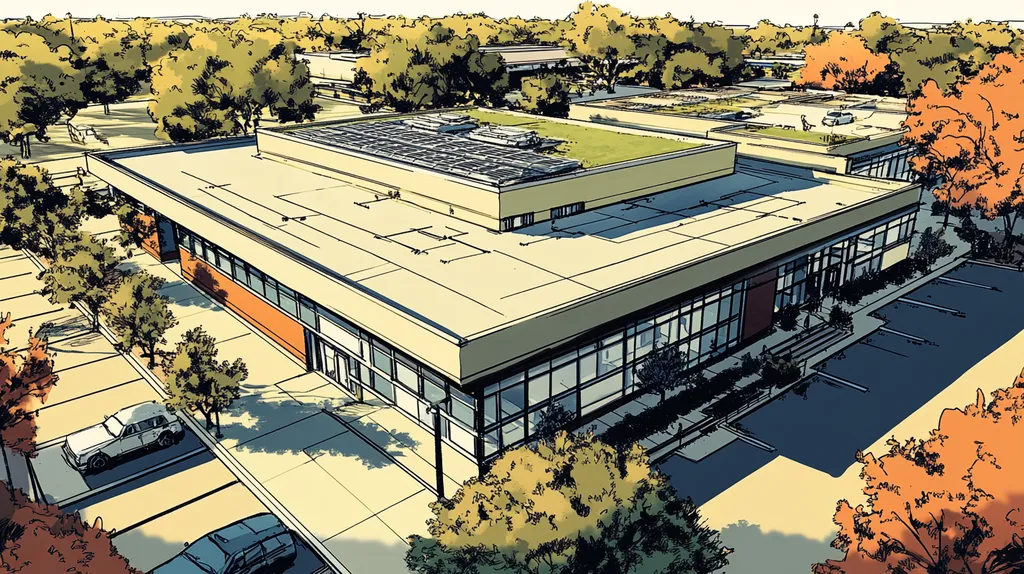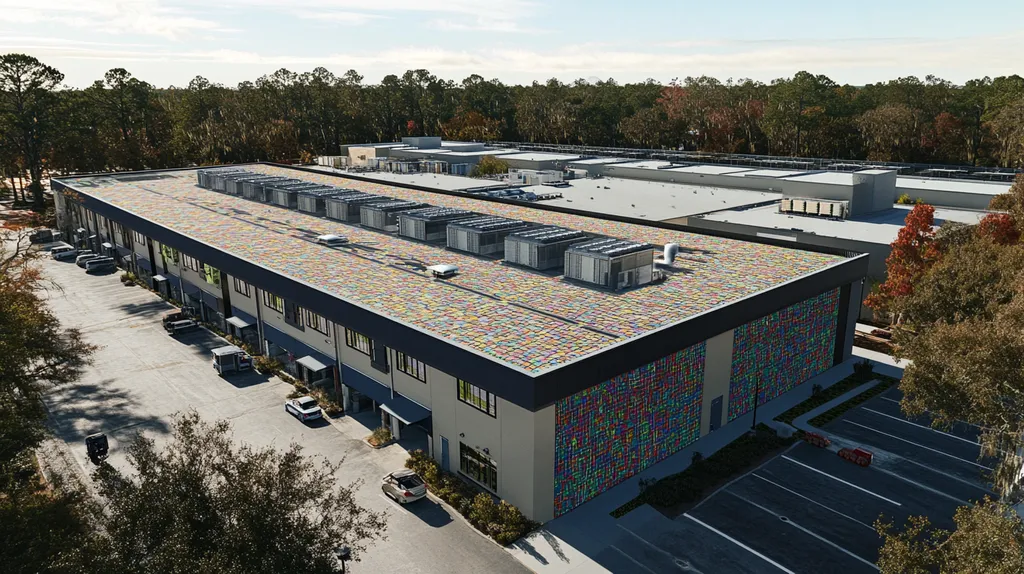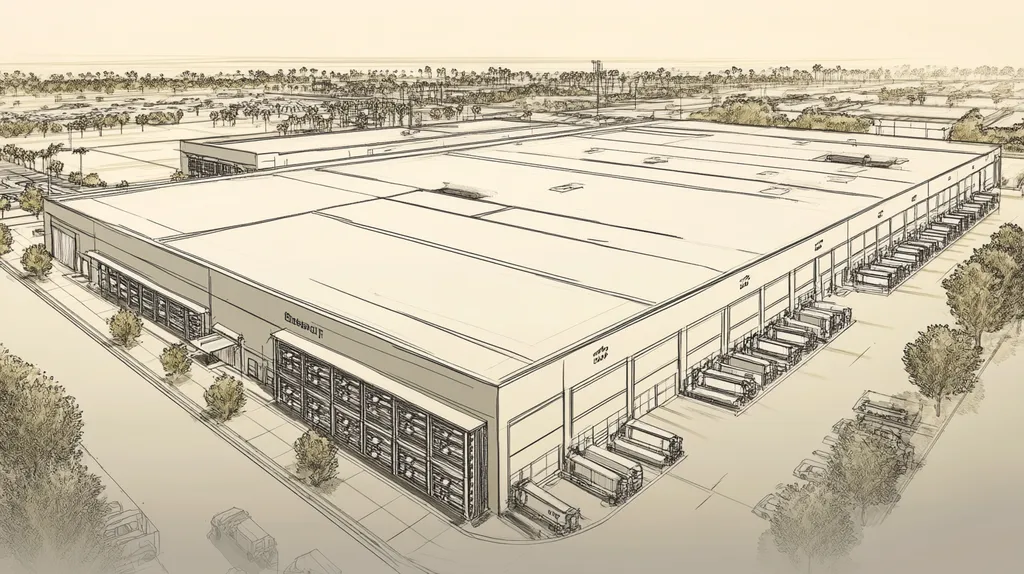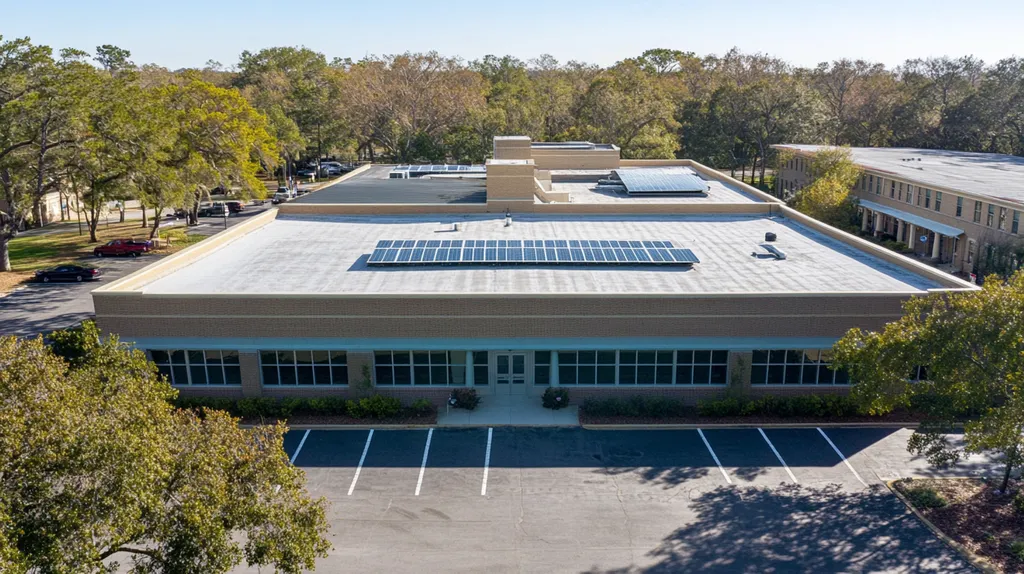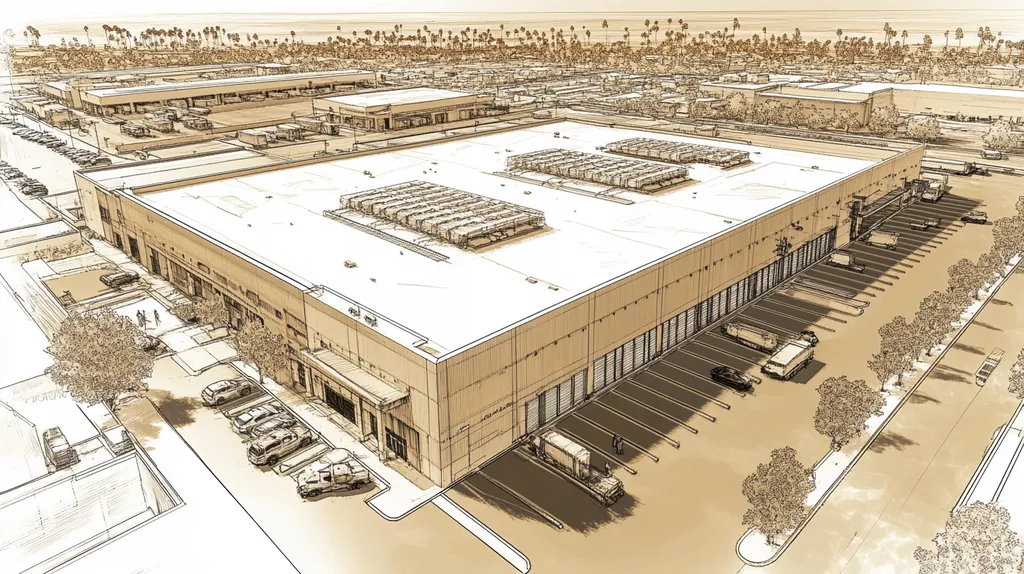In modern industrial facilities, a single day of roofing-related downtime can cost upwards of $50,000 in lost production, making construction impact management critical for operational continuity.
From manufacturing floors to warehousing operations, roofing projects create complex challenges that affect every aspect of facility function – from worker safety to production schedules.
This comprehensive guide examines proven strategies for maintaining operational efficiency during industrial roof construction, exploring essential concepts, components, and implementation methods that minimize disruption while ensuring project success.
SECTION 1: FUNDAMENTAL CONCEPTS
Industrial roofing projects represent a critical intersection between facility maintenance and operational continuity. When roof work begins, the ripple effects can impact every aspect of a facility’s function, from production schedules to worker safety. Operational disruption from roof failure can lead to severe financial repercussions and, in critical sectors, implications for public safety and health. (source: ACR1)
Understanding Roof-Operation Interface Dynamics
The relationship between roofing work and facility operations requires careful orchestration to maintain productivity. Every roofing decision impacts multiple operational touchpoints, from HVAC system functionality to material handling processes.
Roof access requirements often conflict with standard facility operations. Equipment staging areas, material storage, and worker pathways can disrupt normal traffic patterns and create bottlenecks in production flow.
Environmental controls become particularly challenging during roof work. Open roof areas can compromise climate control, affect sensitive equipment, and create quality control issues in manufacturing processes.
Success requires developing detailed interface management plans. These plans must account for production schedules, equipment protection, and maintaining critical facility functions throughout the project duration.
Regulatory Compliance and OSHA Fall Protection Standards
OSHA fall protection requirements establish non-negotiable parameters for roofing work that directly affect operational planning. These standards mandate specific safety zones, equipment placement, and work procedures that must be integrated into daily facility operations.
Safety perimeters and warning lines typically extend beyond the immediate work area. This extended protection zone often requires temporary relocation of ground-level operations and alternative routing for facility traffic.
Mobile equipment and crane operations near roof work zones require additional clearance and coordination. Each lift operation must be planned to avoid conflicts with facility operations while maintaining OSHA-mandated safety distances.
Documentation and safety monitoring systems must operate continuously. This oversight ensures compliance while providing clear communication channels between roofing crews and facility personnel.
Productivity Challenges in Industrial Roofing Workflows
Weather conditions and material logistics present significant workflow challenges. Rain delays, temperature restrictions for material application, and wind limitations can force schedule adjustments that impact facility operations.
Material staging and removal create temporary disruptions to normal facility flow. Coordinating deliveries, crane operations, and debris removal requires careful timing to minimize impact on daily operations.
Different roofing activities generate varying levels of noise and vibration. These disturbances can affect precision manufacturing processes, sensitive equipment, and worker concentration in adjacent areas.
Sequential work phases must align with facility operations. Critical tasks like membrane installation or equipment curb modifications need to be scheduled during planned production downtimes or shift changes.
Recovery periods between work phases allow operations to normalize. These planned breaks help maintain product quality and worker efficiency while ensuring proper roof system installation.
SECTION 2: SYSTEM COMPONENTS
The selection of roofing system components can mean the difference between minimal disruption and catastrophic operational failures. In manufacturing facilities, a single day of downtime from roofing issues can cost upwards of $50,000 in lost production. Critical components must work together as an integrated system to protect operations while providing long-term durability and performance.
Material Selection Criteria for Minimal Downtime
Material choices directly impact installation speed and system longevity. Fast-curing adhesives and mechanically-fastened systems can reduce installation time by up to 40% compared to traditional methods.
Weight restrictions often dictate material options for existing structures. Lightweight systems using PVC or TPO membranes eliminate the need for structural upgrades that could extend project timelines.
Ponding water resistance must be a primary consideration, as standing water can compromise structural integrity and lead to leaks. High-performance membranes with proper slope and drainage prevent water accumulation that causes premature system failure. (source: Instacoat)
Chemical resistance requirements vary by facility type. Food processing plants need materials that resist oils and acids, while manufacturing facilities require protection against industrial emissions and exhaust.
Impact-Resistant Roofing Membranes and Substrates
Impact resistance ratings determine a system’s ability to withstand mechanical damage. FM Global Class 4 rated assemblies provide maximum protection against hail and falling debris common in industrial environments.
Multi-layer systems with reinforced membranes offer superior puncture resistance. This layered approach prevents damage from dropped tools and equipment during maintenance activities.
Cover board selection significantly affects impact performance. High-density gypsum and cement boards provide a rigid substrate that distributes point loads and prevents membrane tears.
Proper substrate attachment methods ensure system integrity during high winds. Enhanced mechanical fastening patterns and adhesive application rates prevent membrane separation under extreme conditions.
Noise Mitigation Components for Business Continuity
Sound transmission class (STC) ratings guide noise control material selection. Higher STC values indicate better sound blocking capabilities, critical for maintaining workplace communication during installation.
Vibration isolation materials prevent mechanical equipment noise from transferring through the roof structure. Proper isolation can reduce transmitted noise by up to 30 decibels.
Strategic placement of sound barriers around work zones contains construction noise. Temporary walls and enclosures redirect sound upward rather than into occupied spaces.
Acoustic membrane underlayments provide permanent noise reduction. These specialized materials dampen impact sounds from rain and maintenance traffic throughout the roof’s service life.
SECTION 3: IMPLEMENTATION METHODS
Industrial roofing projects demand precise execution to prevent costly operational disruptions. Every hour of manufacturing downtime can cost facilities tens of thousands in lost productivity. Strategic implementation methods that balance construction requirements with operational needs have become essential for modern industrial facilities.
Phased Installation for Operational Continuity
Phase-locked installation strategies enable facilities to maintain critical operations throughout roof construction. This systematic approach divides large projects into manageable sections, typically 5,000-10,000 square feet, allowing most facility areas to remain functional during work.
Strategic phasing requires careful coordination with production schedules and equipment locations. Critical manufacturing zones receive priority scheduling, while less essential areas provide flexibility for construction staging.
Each phase incorporates dedicated safety zones and equipment staging areas. These designated spaces prevent conflicts between roofing activities and facility operations while maintaining OSHA compliance.
Phase transition periods allow for thorough quality control inspections and operational adjustments. This measured approach ensures proper installation while minimizing disruption to facility workflows.
Night/Weekend Scheduling Techniques
Off-hours construction scheduling maximizes productive facility uptime. Night crews can complete noisy tear-off work and heavy material staging when manufacturing lines are dormant.
Specialized lighting systems and safety protocols enable efficient nighttime operations. Modern LED arrays provide stadium-quality illumination while minimizing light pollution and energy consumption.
Weekend scheduling allows extended work periods for critical installations. Complex details around HVAC units and roof penetrations receive focused attention without rushing to accommodate daily operations.
Dedicated project managers coordinate after-hours activities with facility maintenance teams. This ensures proper access control and emergency response capabilities during off-peak work periods.
Temporary Weatherproofing During Partial Removal
Comprehensive weatherproofing strategies protect exposed building areas during construction. Properly installed vapor barriers and temporary membranes prevent moisture infiltration that could damage sensitive equipment or inventory. (source: ACR1)
Mobile weather protection units provide flexible coverage for active work zones. These specialized systems can be rapidly deployed or relocated as work progresses across the roof surface.
Emergency response plans include pre-positioned materials and dedicated crews. This preparation ensures rapid protection of exposed areas during sudden weather events.
Daily inspection protocols verify temporary protection integrity. Regular monitoring prevents costly water damage and maintains environmental controls for sensitive manufacturing processes.
SECTION 4: MAINTENANCE REQUIREMENTS
Industrial roofing maintenance during active operations requires precise coordination to prevent catastrophic failures. Even minor oversights in maintenance protocols can trigger chain reactions of equipment damage, production delays, and safety hazards. With industrial facilities operating sophisticated machinery and maintaining strict environmental controls, the cost of improper maintenance can quickly escalate into millions in damages and lost production.
Preventative Inspection Schedules During Operations
Systematic inspection protocols must align with both construction phases and operational demands. Daily visual assessments should focus on high-risk areas where construction activities intersect with critical production zones.
Water infiltration, structural degradation, energy inefficiency, and premature aging pose significant threats to operational continuity during roof work. Regular monitoring helps detect these issues before they can impact sensitive manufacturing processes or compromise worker safety. (source: Instacoat)
Documentation systems must track inspection findings and correlate them with construction activities. This data helps identify patterns that could indicate developing problems requiring immediate attention.
Coordination between inspection teams and facility operations ensures minimal disruption during assessment activities. Scheduling inspections during natural production breaks maximizes efficiency while maintaining thorough oversight.
Emergency Repair Protocols with Occupancy Constraints
Emergency response plans must account for active operations when addressing sudden roof failures. These protocols should outline specific procedures for different scenarios while maintaining production wherever possible.
Mobile repair units equipped with specialized tools and materials enable rapid response without extensive operational shutdown. Strategic positioning of these resources throughout the facility reduces response times during critical situations.
Temporary containment systems protect sensitive equipment and materials during emergency repairs. These systems prevent contamination and maintain environmental controls while repair work proceeds.
Clear communication channels between repair teams and operations staff facilitate coordinated responses. Designated points of contact ensure efficient information flow and decisive action during emergencies.
Warranty Considerations for Active Facilities
Warranty compliance requires careful documentation of maintenance activities during construction phases. Detailed records must demonstrate adherence to manufacturer specifications while accommodating operational constraints.
Material handling and storage protocols protect warranty validity during construction. Proper protection of stored materials prevents degradation that could void coverage or compromise performance.
Integration of warranty requirements into daily operations prevents inadvertent violations. Staff training should cover permitted activities and restrictions that could affect warranty status.
Regular warranty compliance audits ensure maintenance practices align with coverage terms. These reviews identify potential issues before they can compromise warranty protection or facility operations.
SECTION 5: PERFORMANCE METRICS
Performance metrics during industrial roofing projects directly impact operational success and financial outcomes. Every hour of disruption can cost facilities hundreds of thousands in lost productivity and compromised operations. Understanding and tracking key performance indicators allows facility managers to optimize project execution while minimizing costly interruptions.
Downtime Measurement and Cost Analysis
Quick turnarounds and minimized disruptions are essential for maintaining operational continuity during roofing projects. Every minute of operational downtime must be meticulously tracked and analyzed to understand the true cost impact on production schedules and delivery commitments. (source: TQM Roofing Inc.)
Daily tracking logs should document both planned and unplanned downtime events. This data helps identify patterns and opportunities for schedule optimization while providing accountability for project milestones.
Cost analysis must extend beyond direct production losses to include ripple effects. Secondary impacts like overtime labor, expedited shipping, and customer satisfaction metrics paint a complete picture of downtime costs.
Regular reporting and review of downtime metrics enable rapid response to emerging issues. When shared with key stakeholders, this data drives informed decisions about resource allocation and schedule adjustments.
Labor Productivity Tracking Per Square Foot
Measuring labor productivity per square foot reveals efficiency trends and potential bottlenecks. Daily tracking sheets should record crew sizes, hours worked, and square footage completed to establish reliable productivity baselines.
Weather conditions, material delivery timing, and equipment availability all influence productivity rates. Documenting these variables helps explain deviations from expected performance and supports continuous improvement efforts.
Comparing actual versus planned productivity highlights areas needing attention. Early identification of productivity gaps allows for timely corrective actions like additional training or workflow adjustments.
Weekly productivity reports should analyze trends across different project phases. This information guides staffing decisions and helps optimize crew assignments for maximum efficiency.
Weather-Related Delay Probability Assessments
Weather impact analysis requires both historical data and real-time monitoring. Seasonal patterns inform long-term planning while current forecasts guide daily execution decisions.
Probability assessments should consider temperature, precipitation, and wind conditions. These factors directly affect material installation requirements and worker safety parameters.
Contingency plans must address various weather scenarios and their operational implications. Having predetermined responses to weather events reduces reactive decision-making and maintains project momentum.
Weather tracking logs should document actual conditions and their effects on productivity. This data improves future planning accuracy and supports warranty compliance documentation.
SECTION 6: OPTIMIZATION STRATEGIES
Industrial roofing projects demand precise optimization to prevent catastrophic disruptions to facility operations. Every day of inefficient execution can cost facilities hundreds of thousands in lost productivity and compromised operations. Modern optimization strategies leverage lean principles, structured communication, and digital technology to dramatically reduce project timelines while maintaining operational continuity.
Lean Construction Principles in Roof Logistics
Lean construction methodologies can reduce project durations by up to 30% through systematic waste elimination. Just-in-time material deliveries minimize staging area requirements while ensuring crews have exactly what they need when needed.
Pre-assembly of roof components in controlled environments accelerates on-site installation. This approach reduces weather exposure while allowing precise quality control of critical assemblies.
Value stream mapping identifies and eliminates non-value-adding activities that slow progress. Analyzing workflow patterns helps optimize crew movements and material handling to maintain momentum.
Daily huddles with installation teams create opportunities to address potential bottlenecks before they impact schedules. This proactive communication prevents costly delays from cascading through project phases.
Stakeholder Communication Frameworks for Transparency
The U.S. Army Corps of Engineers mandates critical path scheduling methodology to maintain clear visibility of construction progress and resource allocation throughout complex projects. This structured approach ensures all stakeholders understand timing dependencies and milestone requirements. (source: U.S. Army Corps of Engineers)
Daily progress reports track completed work against established milestones. These updates allow facility managers to coordinate operations around construction activities.
Weekly stakeholder meetings address emerging concerns and upcoming phase transitions. Regular dialogue prevents miscommunication that could derail carefully planned sequences.
Digital documentation platforms provide real-time access to project metrics and schedule updates. This transparency enables rapid decision-making when adjustments become necessary.
Technological Integration for Real-Time Project Monitoring
Cloud-based project management systems enable immediate tracking of material usage, labor hours, and milestone completion. This real-time visibility helps project managers optimize resource allocation throughout each phase.
Drone surveys and thermal imaging identify potential issues before they impact operations. Advanced detection capabilities prevent costly surprises that could extend project timelines.
Mobile applications give field teams instant access to project specifications and quality control checklists. This digital connectivity ensures consistent execution across all work areas.
Automated monitoring systems track environmental conditions affecting installation activities. Weather alerts and material temperature monitoring prevent application errors that could compromise long-term performance.
The Bottom Line
With industrial roof failures costing facilities up to $50,000 per day in lost production, the impact of construction on daily operations cannot be overstated.
Modern roofing projects demand sophisticated coordination between construction teams and facility operations to prevent catastrophic disruptions.
Success requires integrating lean construction principles, real-time monitoring technology, and structured communication frameworks throughout every project phase.
By implementing comprehensive maintenance protocols, tracking critical performance metrics, and maintaining strict quality control standards, facilities can complete essential roofing work while preserving operational continuity.
The future of industrial roofing lies in proactive planning, technological integration, and unwavering commitment to minimizing operational impact during construction.
FREQUENTLY ASKED QUESTIONS
Q. How does an industrial roof project impact daily operations?
A. Industrial roof projects can significantly disrupt operations by affecting production schedules and safety protocols. Operational continuity hinges on effective planning to minimize interference with regular activities, as uncoordinated work can lead to costly delays and compromised safety standards.
Q. What material selections can minimize downtime for a commercial roof?
A. Selecting lightweight, fast-curing materials can significantly reduce downtime during installation. High-performance membranes designed for durability and water resistance are crucial for preventing future issues, while also ensuring that installations proceed efficiently without the need for structural upgrades.
Q. What are effective implementation methods for an industrial roof?
A. Phased installation strategies and off-hours construction can effectively balance roofing work with operational needs. Implementing structured transitions and scheduling during downtime helps minimize disruptions while ensuring safety and compliance throughout the project.
Q. How can maintenance be coordinated during roof work on a commercial building?
A. Coordinating systematic inspections with construction phases is vital to ensure operational continuity. Regular visual assessments should focus on critical areas to quickly identify any water infiltration or structural degradation, preventing serious interruptions during roof work.
Q. What performance metrics should facility managers track during roofing projects?
A. Tracking downtime, labor productivity, and weather-related delays are essential for evaluating project success. Documenting unplanned disruptions and their costs enables informed decisions and optimizations for further phases of the roofing project.
Q. What optimization strategies can improve industrial roofing projects?
A. Implementing lean construction principles and enhancing communication channels can significantly optimize roofing projects. This reduces inefficiencies, promotes clear stakeholder engagement, and utilizes advanced tracking technologies for real-time project insights, ensuring smooth execution.
Q. How can stakeholders be effectively communicated with during a roof project?
A. Establishing structured communication frameworks, including daily progress reports and weekly meetings, ensures stakeholders remain informed. Regular updates promote transparency regarding milestones and project adjustments, crucial for maintaining aligned schedules and objectives.

